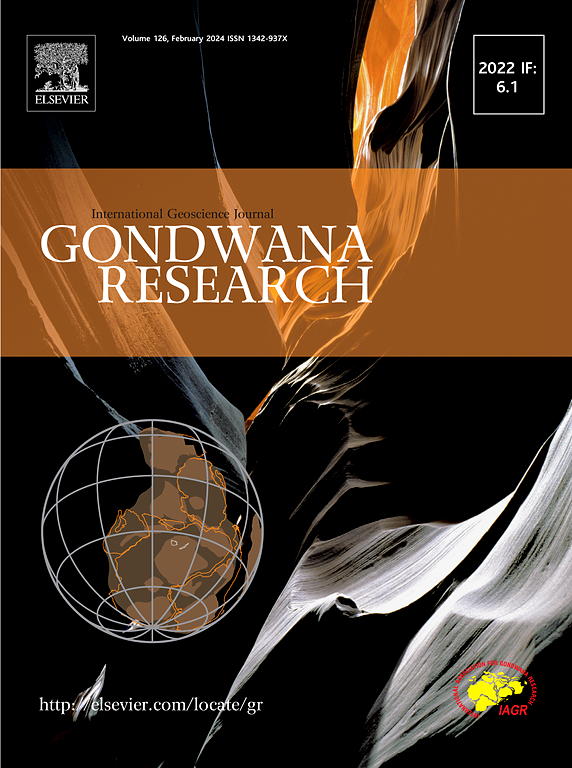The chronology of paleoenvironment: (U-Th)/He dating and δ13C of lateritic duricrusts from the Cuesta and Paulista Peripheral Depression sectors of São Paulo State, southeastern Brazil
IF 7.2
1区 地球科学
Q1 GEOSCIENCES, MULTIDISCIPLINARY
引用次数: 0
Abstract
Lateritic duricrusts are key records of continental weathering processes, landscape evolution, and paleoclimatic conditions in tropical regions. This study aims to assess the timing and paleoenvironmental conditions of lateritic duricrust formation from sectors of the Cuesta and Paulista Peripheral Depression of São Paulo State, southeastern Brazil. The relationship between (U-Th)/He ages and δ13C signatures across different planation surfaces was established in hematite- and goethite-bearing samples from weathering profiles on the Cuesta, Urucaia, and Rio Claro Surfaces. Our results show that lateritic duricrusts on the Urucaia and Cuesta Surfaces, located at higher elevations, are hematite-predominant, whereas those on the Urucaia and Rio Claro Surfaces, situated at lower elevations, are goethite-predominant. The δ13C values indicate the predominance of C4 vegetation during the formation of lateritic duricrusts, associated with regional climatic conditions and the C3–C4 vegetation shift in the Late Miocene. In soils, δ13C values may reflect the effects of land use intensification. The (U-Th)/He ages of the lateritic duricrusts suggest three distinct formation events: Miocene (23–5.3 Ma), Pliocene (5.3–1.6 Ma), and Pleistocene (< 1.6 Ma), with a clear relationship between the chronology of planation surfaces and elevation. The results indicate that lateritic duricrusts on the Cuesta Surface yielded ages ranging from 18 ± 2 Ma to 3 ± 1 Ma, spanning the Miocene and Pliocene. On the Urucaia Surface, ages varied from 20 ± 2 Ma to < 1 Ma, encompassing both the Miocene and Pleistocene. In contrast, the relatively young Rio Claro Surface presented ages < 1 Ma, corresponding to the Pleistocene. The complexity of tectonic and climatic events over time resulted in an overlap of ages, reflecting the formation of lateritic duricrusts in different periods, as evidenced by the Miocene ages on the Urucaia Surface and Pliocene ages found on the Cuesta Surface.

古环境年代学:巴西东南部圣保罗州Cuesta和Paulista外围坳陷段红土硬壳(U-Th)/He定年和δ13C
红土硬壳是热带地区大陆风化过程、景观演化和古气候条件的重要记录。本研究旨在评价巴西东南部圣保罗州Cuesta和Paulista外围凹陷部分红土硬壳形成的时间和古环境条件。在Cuesta、Urucaia和里约热内卢Claro地表风化剖面的赤铁矿和针铁矿样品中,建立了不同平整表面(U-Th)/He年龄与δ13C特征之间的关系。结果表明,乌卢卡亚和奎斯塔表面的红土硬壳以赤铁矿为主,而乌卢卡亚和里约热内卢克拉罗表面的低海拔红土硬壳以针铁矿为主。δ13C值表明红土硬壳形成时期C4植被占优势,与晚中新世区域气候条件和C3-C4植被转移有关。在土壤中,δ13C值可以反映土地利用集约化的影响。红土硬壳的(U-Th)/He年龄反映了中新世(23-5.3 Ma)、上新世(5.3-1.6 Ma)和更新世(< 1.6 Ma) 3个不同的形成时期,夷平面年代学与海拔高度有明显的关系。结果表明,Cuesta地表红土硬壳年龄在18±2 Ma至3±1 Ma之间,跨越中新世至上新世。在乌卢卡亚地表,年龄从20±2 Ma到1 Ma不等,包括中新世和更新世。相比之下,相对年轻的里约热内卢Claro地表的年龄为<; 1 Ma,对应于更新世。随着时间的推移,构造和气候事件的复杂性导致了时代的重叠,反映了红土硬壳在不同时期的形成,如在乌卢卡亚表面发现的中新世和在奎斯塔表面发现的上新世。
本文章由计算机程序翻译,如有差异,请以英文原文为准。
求助全文
约1分钟内获得全文
求助全文
来源期刊

Gondwana Research
地学-地球科学综合
CiteScore
12.90
自引率
6.60%
发文量
298
审稿时长
65 days
期刊介绍:
Gondwana Research (GR) is an International Journal aimed to promote high quality research publications on all topics related to solid Earth, particularly with reference to the origin and evolution of continents, continental assemblies and their resources. GR is an "all earth science" journal with no restrictions on geological time, terrane or theme and covers a wide spectrum of topics in geosciences such as geology, geomorphology, palaeontology, structure, petrology, geochemistry, stable isotopes, geochronology, economic geology, exploration geology, engineering geology, geophysics, and environmental geology among other themes, and provides an appropriate forum to integrate studies from different disciplines and different terrains. In addition to regular articles and thematic issues, the journal invites high profile state-of-the-art reviews on thrust area topics for its column, ''GR FOCUS''. Focus articles include short biographies and photographs of the authors. Short articles (within ten printed pages) for rapid publication reporting important discoveries or innovative models of global interest will be considered under the category ''GR LETTERS''.
 求助内容:
求助内容: 应助结果提醒方式:
应助结果提醒方式:


